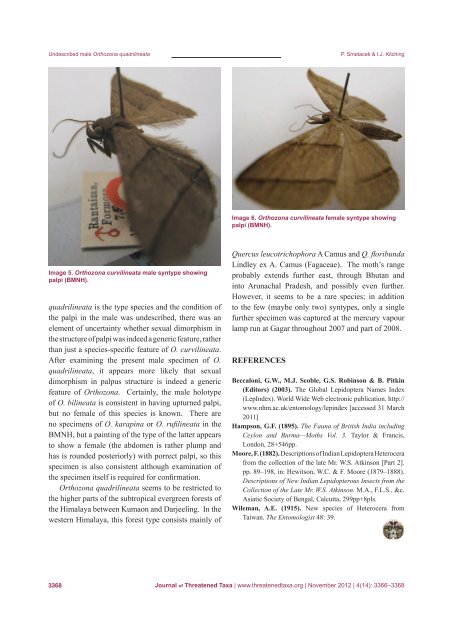Undescribed male Orthozona quadrilineataP. Smetacek & I.J. KitchingImage 6. Orthozona curvilineata female syntype showingpalpi (BMNH).Image 5. Orthozona curvilineata male syntype showingpalpi (BMNH).quadrilineata is the type species and the condition <strong>of</strong>the palpi in the male was undescribed, there was anelement <strong>of</strong> uncertainty whether sexual dimorphism inthe structure <strong>of</strong> palpi was indeed a generic feature, ratherthan just a species-specific feature <strong>of</strong> O. curvilineata.After examining the present male specimen <strong>of</strong> O.quadrilineata, it appears more likely that sexualdimorphism in palpus structure is indeed a genericfeature <strong>of</strong> Orthozona. Certainly, the male holotype<strong>of</strong> O. bilineata is consistent in having upturned palpi,but no female <strong>of</strong> this species is known. There areno specimens <strong>of</strong> O. karapina or O. rufilineata in theBMNH, but a painting <strong>of</strong> the type <strong>of</strong> the latter appearsto show a female (the abdomen is rather plump andhas is rounded posteriorly) with porrect palpi, so thisspecimen is also consistent although examination <strong>of</strong>the specimen itself is required for confirmation.Orthozona quadrilineata seems to be restricted tothe higher parts <strong>of</strong> the subtropical evergreen forests <strong>of</strong>the Himalaya between Kumaon and Darjeeling. In thewestern Himalaya, this forest type consists mainly <strong>of</strong>Quercus leucotrichophora A Camus and Q. floribundaLindley ex A. Camus (Fagaceae). The moth’s rangeprobably extends further east, through Bhutan andinto Arunachal Pradesh, and possibly even further.However, it seems to be a rare species; in additionto the few (maybe only two) syntypes, only a singlefurther specimen was captured at the mercury vapourlamp run at Gagar throughout 2007 and part <strong>of</strong> 2008.REFERENCESBeccaloni, G.W., M.J. Scoble, G.S. Robinson & B. Pitkin(Editors) (2003). The Global Lepidoptera Names Index(LepIndex). World Wide Web electronic publication. http://www.nhm.ac.uk/entomology/lepindex [accessed 31 March2011]Hampson, G.F. (1895). The Fauna <strong>of</strong> British India includingCeylon and Burma—Moths Vol. 3. Taylor & Francis,London, 28+546pp.Moore, F. (1882). Descriptions <strong>of</strong> Indian Lepidoptera Heterocerafrom the collection <strong>of</strong> the late Mr. W.S. Atkinson [Part 2].pp. 89–198, in: Hewitson, W.C. & F. Moore (1879–1888).Descriptions <strong>of</strong> New Indian Lepidopterous Insects from theCollection <strong>of</strong> the Late Mr. W.S. Atkinson. M.A., F.L.S., &c.Asiatic Society <strong>of</strong> Bengal, Calcutta, 299pp+8pls.Wileman, A.E. (1915). New species <strong>of</strong> Heterocera fromTaiwan. The Entomologist 48: 39.3368<strong>Journal</strong> <strong>of</strong> <strong>Threatened</strong> <strong>Taxa</strong> | www.threatenedtaxa.org | November 2012 | 4(14): 3366–3368
JoTT No t e 4(14): 3369–3372First record <strong>of</strong> two tubuliferan and fourterebrantian species <strong>of</strong> Thysanoptera(Insecta) from northeastern IndiaKh. Bala 1 , O. Tarunkumar Singh 2 , H. Taptamani3& R. Varatharajan 41,2,3,4Centre <strong>of</strong> Advanced Study in Life SciencesManipur University, Imphal, Manipur 795003, IndiaEmail: 1 balakhkm@gmail.com, 2 otsingh2010@gmail.com,3tapta18jan@gmail.com, 4 rvrajanramya@rediffmail.com(corresponding author)The order Thysanoptera popularly known as thripsor fringe wings are known to be <strong>of</strong> considerablesignificance as they feed on food and horticulturalplants and also due to their ability to act as vectors<strong>of</strong> some bacterial, fungal and viral diseases <strong>of</strong> plants(David & Ananthakrishnan 2004). In spite <strong>of</strong> extensivetaxonomic contributions mainly by Ananthakrishnan& Sen (1980) and Bhatti (1994), there is a paucity<strong>of</strong> information on thrips <strong>of</strong> northeastern India. Allspecimens were collected during the present studyfrom Manipur and Nagaland. Prior to this, theiroccurrences were known only from a few SoutheastAsian countries. Specimens collected in the presentstudy are deposited in the insect museum <strong>of</strong> theDepartment <strong>of</strong> Life Sciences, Manipur University.Date <strong>of</strong> publication (online): 26 November 2012Date <strong>of</strong> publication (print): 26 November 2012ISSN 0974-7907 (online) | 0974-7893 (print)Editor: K.G. SivaramakrishnanManuscript details:Ms # o3052Received 03 January 2012Final received 12 May 2012Finally accepted 02 September 2012Citation: Bala, K., O.T. Singh, H. Taptamani & R. Varatharajan (2012). Firstrecord <strong>of</strong> two tubuliferan and four terebrantian species <strong>of</strong> Thysanoptera(Insecta) from northeastern India. <strong>Journal</strong> <strong>of</strong> <strong>Threatened</strong> <strong>Taxa</strong> 4(14):3369–3372.Copyright: © Kh. Bala, O. Tarunkumar Singh, H. Taptamani & R.Varatharajan 2012. Creative Commons Attribution 3.0 Unported License.JoTT allows unrestricted use <strong>of</strong> this article in any medium for non-pr<strong>of</strong>itpurposes, reproduction and distribution by providing adequate credit to theauthors and the source <strong>of</strong> publication.Acknowledgements: The authors thank the Ministry <strong>of</strong> Environment andForest, New Delhi for the financial support and to the Head, Department <strong>of</strong>Life Sciences, Manipur University for the laboratory facilities.urn:lsid:zoobank.org:pub:B8555A58-0C76-46F0-9EA2-D7906177E907OPEN ACCESS | FREE DOWNLOADThe present new records willhopefully motivate future workersto engage in indepth survey andtaxonomic explorations <strong>of</strong> thripsin the north-east, a biodiversity hotspot.Suborder: TubuliferaFamily: Phlaeothripidae1. Baenothrips asper (Bournier, 1963)Transithrips asper Bournier, 1963, Publ. Cult. Co.Diam. Angola, 63: 81.Transithrips asper Bournier-Ananthakrishnan, 1966,Bull.Ent., 7: 11.Baenothrips asper (Bournier) - Mound, 1972. Aust. J.Zool., 20: 92.Baenothrips asper (Bournier) - Ananthakrishnan &Sen, 1980, Zool. Surv. India, Handbk. Ser., 1: 82 &145.Baenothrips asper (Bournier) - Bhatti, 2002, OrientalInsects, 36: 1–28.Specimen studied: 12 females, 25.ii.2002, 1400m,ex. mixed leaf litter, Khuzama (Nagaland), (MU/LSDNo. B/Myco/17) (Table 1 and Image 1).Distribution: India [Eastern Ghat (apterous form),Nagaland (macropterous form - new record)], Angola,Luanda, Taiwan.Comments: As early as 1963, Bournierdescribed the macropterous form <strong>of</strong> Baenothripsasper (= Transithrips asper) from Angola, Africa.Subsequently, occurrence <strong>of</strong> B. asper was reportedfrom India (Ananthakrishnan 1966) and Taiwan(Kudo 1978) based on the apterous individuals.However, Bhatti (2002) on examining the Indianmaterials felt that there could be two different species<strong>of</strong> Baenothrips including that <strong>of</strong> apterous B. asper, butthe identity <strong>of</strong> the latter did not match with the wingedform <strong>of</strong> Angolan species. Recently, during the surveyin Nagaland, a dozen individuals <strong>of</strong> the macropterousform <strong>of</strong> B. asper were collected from mixed leaflitter. The characters <strong>of</strong> these specimens were foundidentical with that <strong>of</strong> Angolan materials <strong>of</strong> B. asper,that being recharacterized by Bhatti (2002) based on itsparatypes. Further, a comparative account <strong>of</strong> certainmorphometric data (Table 1) <strong>of</strong> the materials collectedduring the present study also showed similarity withthat <strong>of</strong> Angolan specimens as provided by Bhatti (2002).Such comparisons on morphometric measurements<strong>Journal</strong> <strong>of</strong> <strong>Threatened</strong> <strong>Taxa</strong> | www.threatenedtaxa.org | November 2012 | 4(14): 3369–3372 3369

















